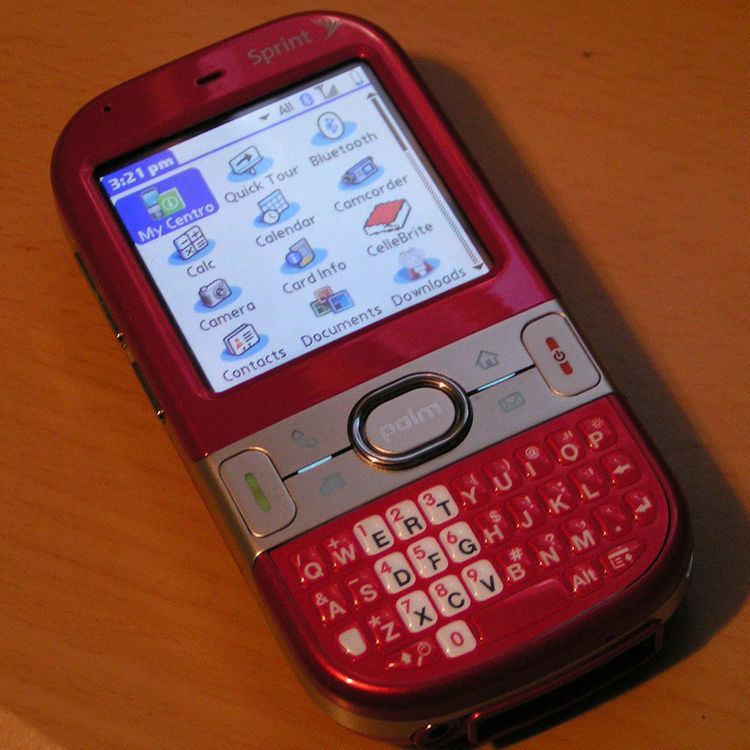Manufacturer Palm, Inc. Weight 4.2 oz (119 g) | Operating system | |
 | ||
Dimensions 4.22 × 2.11 × 0.73 in(107 × 54 × 18.5 mm) | ||
The Palm Centro is a smartphone that was marketed by Palm, Inc. beginning with its release on October 14, 2007, offering the functionality of the larger Treo 755p in a smaller size.
Contents
- Specifications
- Operating system
- Sprint
- ATT
- Verizon
- Claro
- Telstra
- Rogers Wireless
- Unlocked GSM
- Bell Mobility
- Advertising
- References
As of August 2008, the Palm Centro was the second-ranked US smartphone based on internet traffic, responsible for 78% of the traffic on Palm devices; it fell to fourth in February 2009, responsible for 86% of Palm traffic.
The Centro is among the last devices released with the Palm OS operating system, superseded by Palm's webOS, which debuted on the Palm Pre in June 2009.
Specifications
At a weight of 119 g, and dimensions of 4.2″ (h), 2.1″ (w) and 0.7″ (d), the Centro was the smallest smart phone offered from Palm up to its introduction. It includes a 1.3-megapixel digital camera with video capture capabilities, microSD card slot (supporting up to 8GB microSD cards), touch screen navigation and a QWERTY keyboard. The phone is available with either CDMA technology supporting EVDO Rev 0 for network access, or GSM. The stock battery allows for up to 3.5 hours of continuous talk time. The phone also offers internet connection tethering to laptop or desktop computers.
Included with the phone is an A/C travel charger and USB data cable.
Palm has subsequently upgraded the available memory to 128 MB. The updated models are available only on Sprint.
The Palm Centro also has support for (Java) MIDP 2.0, though Palm has discontinued distributing it due to licensing.
The product SKU on this model is PTR690HK, which is aligned with products in the Trēo family of Palm smartphones. The Verizon Wireless SKU is CENTRO690P.
Operating system
The Centro runs Palm OS 5.4.9, and as a result of the backward compatibility aspects of this operating system, many applications released for previous Palm PDA/smartphones work with the Centro. This phone has been streamlined to work with many popular applications and services.
Sprint
Sprint has marketed the Centro in red, black and pink and released new colors in October 2008, Olive Green and Vibrant Rose. The new model has double the user accessible storage as the preceding model. It also features a rubberized soft-touch coating.
AT&T
The AT&T version is available in black, white and electric blue. It uses the GSM cellular network for connectivity and does have some differences from Sprint's CDMA version. The GSM-based device is quad-band (850/900/1800/1900 MHz) and supports both GPRS and EDGE data protocols. Even though the Sprint and Verizon versions of the Centro supports 3G (EV-DO), the AT&T version does not. AT&T customers with quad-band devices such as Centro can place calls in more than 195 countries and access data in more than 140.
PC Magazine writes: "The Centro for AT&T sacrifices the Sprint version's high-speed data access, but you get more battery life—though not quite enough. Nonetheless, the low price makes it a good first smartphone."
The AT&T Centro also offers a Push-To-Talk Walkie-talkie like service not available on the CDMA device. This allows you to instantly see the availability of your contacts before calling them and make individual or group Push-To-Talk calls.
Verizon
The Verizon version of the Centro, available in dark blue only, was released on June 12, 2008 for $99 with a two-year contract and a $70 mail in rebate. This version runs on a 1xRTT/1xEV–DO (Rev.0) 3G network.
Claro
Claro introduced the model to Brazilian market by the beginning of 2008. Curiously, the price for the Centro model is still above the old Treo 680 Palm model (as of June 2008).
Telstra
Telstra Australia sees the Centro offered via PrePaid only. Good Gear Guide writes: "The first smartphone with a full QWERTY keyboard to be sold in Australia on pre-paid". The device is white but unlike the green number pad seen on AT&T's Centro, this version has a grey number pad.
Rogers Wireless
Rogers Wireless (Canada) announced they would be carrying the Palm Centro as of June 10, 2008. It comes in "Cobalt Blue", the same colour as Verizon's Centro. It is selling at $299.99 for new activations with any three-year voice and data plan activation with minimum $45 monthly service fee or $199.99 with any three-year voice and data plan renewal.
Unlocked GSM
On June 25, 2008, an Unlocked GSM version of the Centro was released for use on all 850/900/1800/1900 MHz GSM telephone networks. It was released in Glacier White with grey keyboard accents.
Bell Mobility
As of February 2, 2009, a CDMA version of the Palm Centro in Midnight Black was released on the Bell Mobility network. The phone will begin selling for $49.95 with a new activation on a 3-year $45+ voice and data package. This version runs on a 1xRTT/1xEV–DO (Rev.0) 3G network.
Advertising
In December 2008, Palm created a holiday advertising campaign, introducing a new version of Santa Claus, called "Claus", and complemented the TV spots with a Facebook page, viral videos and original music in download form.
